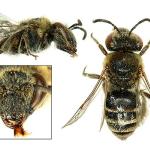Colletes balteata NYLANDER 1852; Colletes thomsoni ALFKEN 1899; Colletes sierrensis FREY-GESSNER 1903
The accompanying map is considered to be a clear representation of this species' entire distribution in Britain. It is apparently absent from Ireland. C. marginatus is a very local bee, although it is sometimes numerous where found. There is little evidence of any major decline, though in Dorset it was formerly found at Studland but was last recorded from there in 1938 (S P M Roberts, pers. comm.). A 1905 record from Swanage is shown on the map, though this specimen too is likely to have been collected nearby at Studland.
A Nationally Notable species (Na) (Falk 1991).
In Britain this is predominantly a bee of coastal dunes, though it is also quite widespread on grass heaths in the Brecklands of East Anglia. Elsewhere, it may be found on light, sandy soils.
Single-brooded; late June to mid-August.
Nests of this bee are constructed in burrows excavated in the soil and are not often encountered. They have been reported as occurring in aggregations, though in Hampshire I have found a single burrow entrance in firm, sparsely vegetated sand. The depth of the burrow and the arrangement of the cells within it are not known.
Mignonette (Reseda lutea), white clover (Trifolium repens), sea-holly (Eryngium maritimum), parsley water-dropwort (Oenanthe lachenallii), cowbane (Cicuta virosa), fennel (Foeniculum officinale), angelica (Angelica sylvestris), wild parsnip (Pastinaca sativa), hogweed (Heracleum sphondylium), wild carrot (Daucus carota), sea spurge (Euphorbia paralias), heather (Calluna vulgaris), thrift (Armeria maritima), dodder (Cuscuta epithymum), sheep's-bit (Jasione montana), ragwort (Senecio jacobaea) and creeping thistle (Cirsium arvense). It is not known if these are pollen sources.
A small race of Epeolus cruciger is considered to be a cleptoparasite of C. marginatus (Richards 1937).
Profile written:
Updated: January 2012


